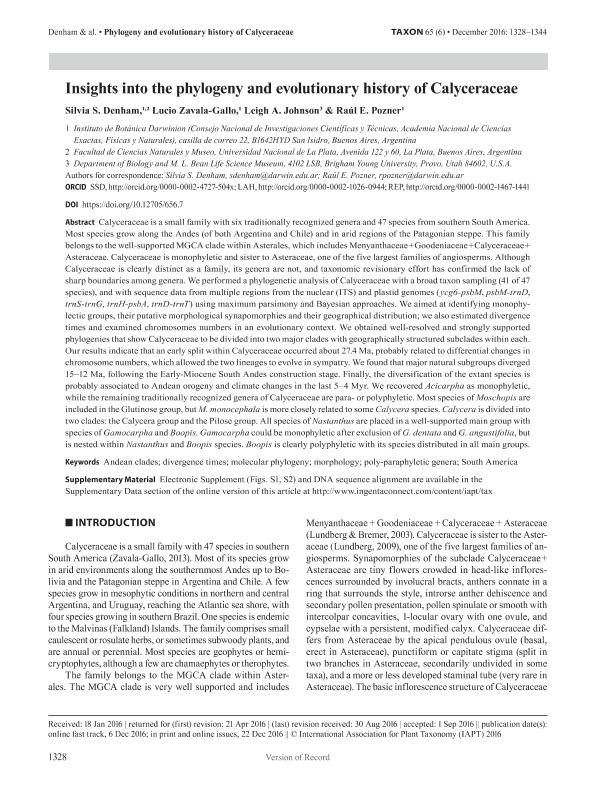Mostrar el registro sencillo del ítem
dc.contributor.author
Denham, Silvia Suyai

dc.contributor.author
Zavala Gallo, Lucio Martín

dc.contributor.author
Johnson, LeighA.
dc.contributor.author
Pozner, Raúl Ernesto

dc.date.available
2018-05-08T19:41:13Z
dc.date.issued
2016-12
dc.identifier.citation
Denham, Silvia Suyai; Zavala Gallo, Lucio Martín; Johnson, LeighA.; Pozner, Raúl Ernesto; Insights into the phylogeny and evolutionary history of Calyceraceae; International Association for Plant Taxonomy; Taxon; 65; 6; 12-2016; 1328-1344
dc.identifier.issn
0040-0262
dc.identifier.uri
http://hdl.handle.net/11336/44487
dc.description.abstract
Calyceraceae is a small family with six traditionally recognized genera and 47 species from southern South America. Most species grow along the Andes (of both Argentina and Chile) and in arid regions of the Patagonian steppe. This family belongs to the well-supported MGCA clade within Asterales, which includes Menyanthaceae + Goodeniaceae + Calyceraceae + Asteraceae. Calyceraceae is monophyletic and sister to Asteraceae, one of the five largest families of angiosperms. Although Calyceraceae is clearly distinct as a family, its genera are not, and taxonomic revisionary effort has confirmed the lack of sharp boundaries among genera. We performed a phylogenetic analysis of Calyceraceae with a broad taxon sampling (41 of 47 species), and with sequence data from multiple regions from the nuclear (ITS) and plastid genomes (ycg6-psbM, psbM-trnD,trnS-trnG, trnH-psbA, trnD-trnT) using maximum parsimony and Bayesian approaches. We aimed at identifying monophylectic groups, their putative morphological synapomorphies and their geographical distribution; we also estimated divergence times and examined chromosomes numbers in an evolutionary context. We obtained well-resolved and strongly supported phylogenies that show Calyceraceae to be divided into two major clades with geographically structured subclades within each. Our results indicate that an early split within Calyceraceae occurred about 27.4 Ma, probably related to differential changes in chromosome numbers, which allowed the two lineages to evolve in sympatry. We found that major natural subgroups diverged 15?12 Ma, following the Early-Miocene South Andes construction stage. Finally, the diversification of the extant species is probably associated to Andean orogeny and climate changes in the last 5?4 Myr. We recovered Acicarpha as monophyletic, while the remaining traditionally recognized genera of Calyceraceae are para- or polyphyletic. Most species of Moschopis are included in the Glutinose group, but M. monocephala is more closely related to some Calycera species. Calycera is divided into two clades: the Calycera group and the Pilose group. All species of Nastanthus are placed in a well-supported main group with species of Gamocarpha and Boopis. Gamocarpha could be monophyletic after exclusion of G. dentata and G. angustifolia, but is nested within Nastanthus and Boopis species. Boopis is clearly polyphyletic with its species distributed in all main groups.
dc.format
application/pdf
dc.language.iso
eng
dc.publisher
International Association for Plant Taxonomy

dc.rights
info:eu-repo/semantics/openAccess
dc.rights.uri
https://creativecommons.org/licenses/by-nc-sa/2.5/ar/
dc.subject
Andean Clades
dc.subject
Divergence Times
dc.subject
Molecular Phylogeny
dc.subject
Morphology
dc.subject
Poly- Paraphyletic Genera
dc.subject
South America
dc.subject.classification
Otras Ciencias Biológicas

dc.subject.classification
Ciencias Biológicas

dc.subject.classification
CIENCIAS NATURALES Y EXACTAS

dc.title
Insights into the phylogeny and evolutionary history of Calyceraceae
dc.type
info:eu-repo/semantics/article
dc.type
info:ar-repo/semantics/artículo
dc.type
info:eu-repo/semantics/publishedVersion
dc.date.updated
2018-05-04T14:58:50Z
dc.journal.volume
65
dc.journal.number
6
dc.journal.pagination
1328-1344
dc.journal.pais
Austria

dc.journal.ciudad
Viena
dc.description.fil
Fil: Denham, Silvia Suyai. Consejo Nacional de Investigaciones Científicas y Técnicas. Instituto de Botánica Darwinion. Academia Nacional de Ciencias Exactas, Físicas y Naturales. Instituto de Botánica Darwinion; Argentina. Universidad Nacional de La Plata. Facultad de Ciencias Naturales y Museo; Argentina
dc.description.fil
Fil: Zavala Gallo, Lucio Martín. Consejo Nacional de Investigaciones Científicas y Técnicas. Instituto de Botánica Darwinion. Academia Nacional de Ciencias Exactas, Físicas y Naturales. Instituto de Botánica Darwinion; Argentina
dc.description.fil
Fil: Johnson, LeighA.. Brigham Young University; Estados Unidos
dc.description.fil
Fil: Pozner, Raúl Ernesto. Consejo Nacional de Investigaciones Científicas y Técnicas. Instituto de Botánica Darwinion. Academia Nacional de Ciencias Exactas, Físicas y Naturales. Instituto de Botánica Darwinion; Argentina
dc.journal.title
Taxon

dc.relation.alternativeid
info:eu-repo/semantics/altIdentifier/doi/https://dx.doi.org/10.12705/656.7
dc.relation.alternativeid
info:eu-repo/semantics/altIdentifier/url/http://www.ingentaconnect.com/content/iapt/tax/2016/00000065/00000006/art00007
Archivos asociados
